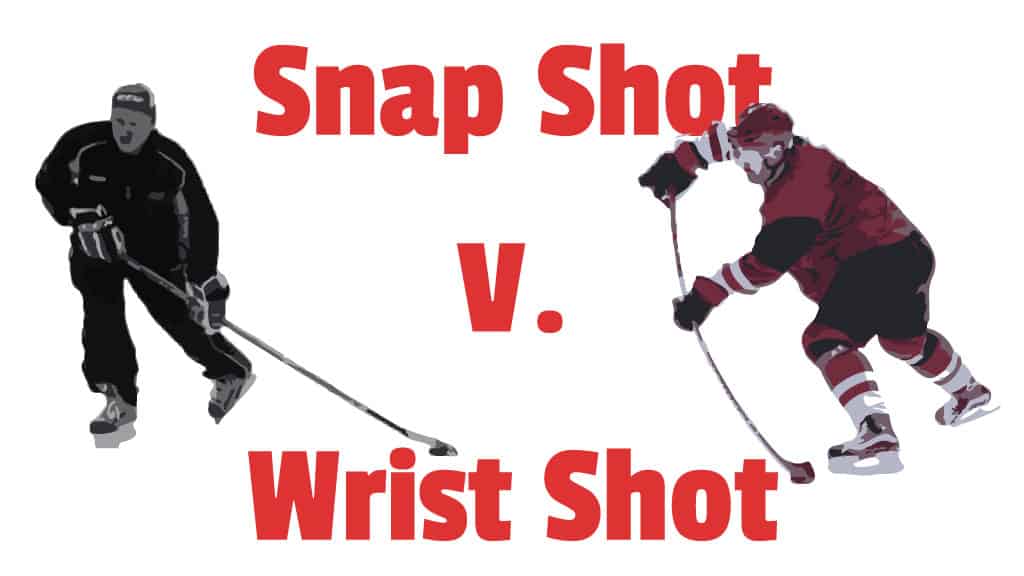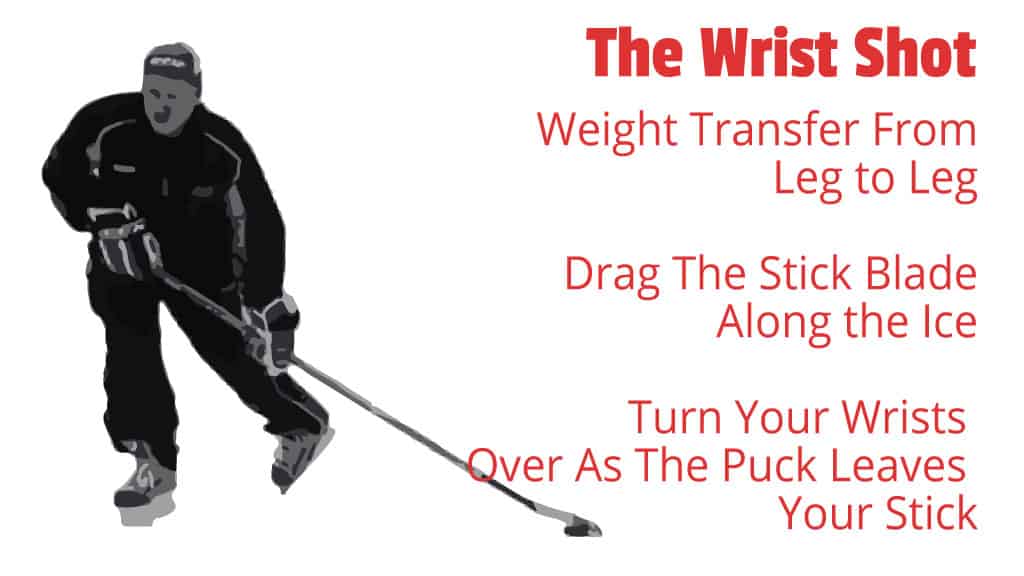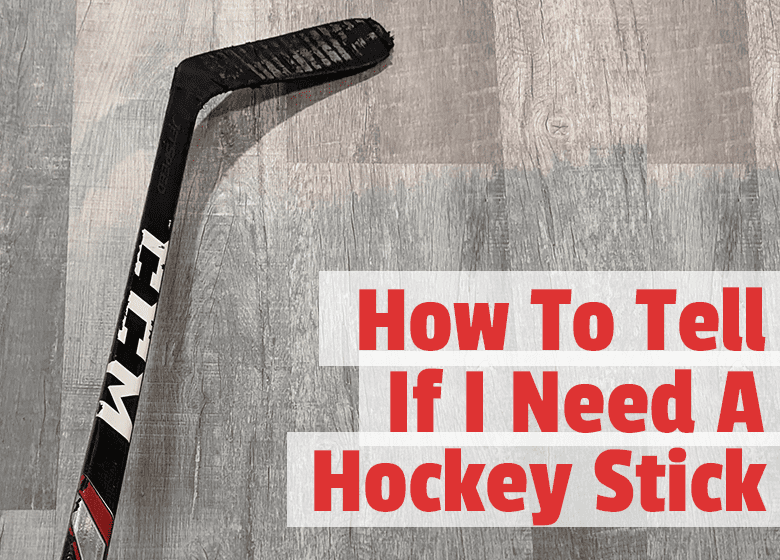
Wristshots and snap shots are some of the more popular shots in the game of hockey. But what is the difference between them? They do look pretty similar.
A snapshot is a quicker, oftentimes less powerful version of a wrist shot which can catch the goalie off guard. A wrist shot is done by applying pressure with your bottom hand and dragging the blade of your stick along the ice using the power of your forearms and wrists to sling the puck off of your blade. A snapshot is performed by quickly snapping the blade of your stick on the ice and striking the puck.
Continue reading and we will go deeper into the differences, the best time to use each type of shot and how to get better at each one.
What is a snapshot and how is it different from a wrist shot?
Snap shots are accurate and fast shots. they are a very useful shot to know in the game of hockey. A snapshot is a very quick release shot. It does not take as much time to get off as a wrist shot does.
A snapshot is typically much less powerful than a wrist shot because you are not winding up as much.
When taking a snap shot you do not drag the blade of your stick along the ice for a long period of time. You want the puck slightly in front of the blade and you want to force your stick into the ice and pull back with your top hand to really snap that puck off of the blade quickly.
With a wrist shot, you are dragging the blade of your stick along the ice, loading the shaft of your stick with lots of potential energy. You are also doing lots of weight transfer from one leg to another when taking a wrist shot. This weight transfer will generate a lot of power on your wrist shots.
With a snap shot, you are not really transferring your weight from one leg to another but instead, you are leaning into your stick, using your body weight to help you flex the shaft of your stick to generate power.
Both shots are great to know but using each one in the right situation will really take your game to the next level.
When should I use a snap shot in a hockey game?
As we mentioned earlier, snap shots are quick-release shots. The best time to use these types of shots is when you do not have a lot of time or when you see an opening in the net that you think will close quickly.
Best times to use a snap shot:
- In front of the net when defenders are on you
- When getting your stick on a rebound the goalie coughed up
- When skating into the offensive zone and defenders are closing in on you.
Really anytime that you want to get a shot off quickly is the ideal time to use a snap shot. There are an unlimited number of game scenarios that you could use this type of shot.
Let’s say that you are crashing the net and your teammate takes a shot that rebounds to you and you have defenders close by but the goalie is out of position. This is the perfect time for a quick snap shot.
You want to get that shot off fast before the goalie has a chance to move into position and before the defenders have time to surround you.
When should I use a wrist shot in a game of hockey?
Wrist shots are more powerful shots than snap shots. This added power comes with a downside when compared to a snap shot and that thing that you sacrifice is speed. It takes more time to shot the puck with a wrist shot than it does a snap shot.
So if you are being pressured or are really close in on the goalie, a wrist shot may not be the most ideal shot to take.
The best times to use a wrist shot are:
- When you have time and space in the slot
- From the point when looking for a deflection
- Looking for a rebound off of the goalie
- When you are not worried about defenders pressuring you
Wrist shots are amazing shots to have in your tool bag. As with snap shots, there are a ton of game scenarios where a wrist shot is the right shot to take.
My two favorite times to take a wrist shot are when I’m playing defense and there is a lot of traffic in front of the net. A low, hard wrist shot is a great chance for a deflection.
Another great time to take a wrist shot in a game is when you and a teammate are coming into the offensive zone but you don’t really have a passing lane. If you take a low hard wrist shot you can force the goalie to cough up a rebound and hopefully, that will bounce right to your crashing team mate.
How do you take a good snapshot?

Quick tips for getting a better snap shot:
- Get your hands away from your body
- Pull with your top hand and push down with your bottom hand
- Make sure the puck is not too far in front or behind you
- Practice generating power with your wrists and forearms
Snap shots are faster versions of a wrist shot. In my mind, I also like to think of it a bit like a slap shot as well.
There is an element of using the ice to flex your stick and generate power by striking the ice before the puck.
With a wrist shot, you are dragging the blade of your stick along the ice the entire time right before releasing the puck. With a snap shot you are pushing the puck slightly ahead of your stick and using your wrists and forearms to snap the puck.
Tip number one to get better at snap shots is to make sure the puck is in the right place when taking your shot. You do not want the puck too far behind you or in front of you. Make sure the puck is in line with your toes.
Focus on getting power from your wrist and forearms. With any shot, your bottom hand is used to lean into the ice and your top hand is used to pull the stick toward you.
In order to do that you need to get your hands away from your body. REally exaggerate this thought, its going to feel uncomfortable at first to get your hands so far away from your body but this is how you are going to get a better snap shot.
Also really use your bottom hand to press into the ice. This will help you get more flex on the stick when you combine a downward force with your bottom hand and a quick pulling motion with your top hand. If you can get the timing on this motion right you will really get a nice snap on your shot.
How to get better at wrist shots

Wrist shots generate a lot more power than snap shots. The name can be a bit confusing though. You would think with a name like wrist shot that this shot is all about your wrists.
That is not 100% true.
While there is a lot of motion in your wrists that will affect this shot, the real secret behind this shot has to do with your legs and weight transfer.
The power from the wrist shot comes from the transfer of your weight from one leg to the other. To get a better wrist shot you should really focus on transferring your weight into your stick at the right time. This is what really helps you flex your stick.
- Start with the puck in the middle of your foot
- Get your hands away from your body
- Pull back with your top hand and push down, into the ice with your bottom hand
- Drag the blade of your stick on the ice the entire time
- As you are pulling the puck forward you should be transferring your weight from the leg opposite of your stick side to the leg closest to your stick
- As the puck is leaving your blade you want to turn your wrists over
The final motion of this shot is all in the wrists. If you forget to turn your wrists over, you will get a puck that is very fluttery and it will not be as powerful as it could be.
The wrist shot does require some core, forearm, and shoulder power but perfecting the wrist shot is all about timing and technique.
Really focus on dragging the blade of your stick across the ice from the middle of your foot all the way through the release point while transferring your weight into the stick as you move your weight from your back leg to your front leg.
As you are transferring your weight be sure to push downward, into the ice with your bottom hand and pull back towards your body with your top hand, just like with a snap shot.
The final motion in the wrist shot is all in the wrist. Do not forget to turn your wrists over to close your blade.
Snap Shot Vs. Wrists Shots And When To Use Them
In hockey, Snap shots are shots that you can get off very quickly. They are a condensed version of the wrist shot. For this reason, they are less powerful but they are very accurate.
The best situations to use a snap shot in a game are when you see an opening in the net and need to get a shot off quickly or when defenders are surrounding you and you need to get a shot on net instead of a turnover.
Wrist shots are much more powerful than a snap shot but that extra power comes at a cost when you compare the wrist shot to a snap shot. A wrist shot will take longer to execute than a snap shot will.
Wrist shots are great when you have time and space in the slot to take a shot or when you are shooting from the blue line looking for a deflection.

